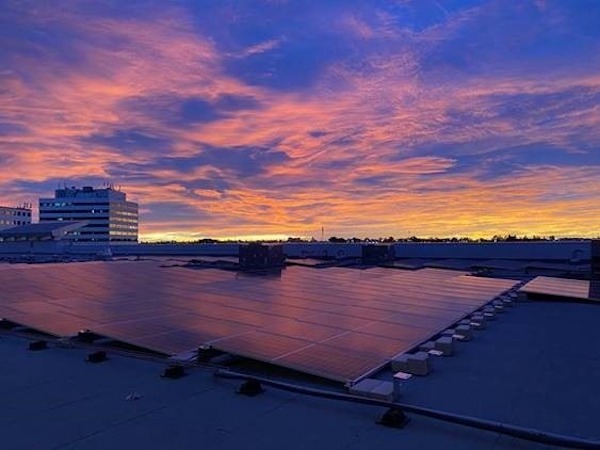
While there are clear advantages to harvesting renewable energy from the sun, important design and installation considerations must be made to ensure those benefits shine.
The first consideration concerns the type of solar panel technology used to convert sunlight into energy. Today, there are two primary methods:
Photovoltaics (V), solar panel technology that generates power by using materials that absorb light and produce electrons (aka the photovoltaic effect), such as silicon and arsenide.
Concentrated solar power (CSP), which are panels comprised of mirrors and tracking systems that concentrate sunlight onto a small heat collector.
PVs are the most common type of solar panels found on top of modern buildings. They are typically supported by a mechanically fastened racking system or ballast restrained system. The former is attached to the roof by penetrating the roofing membrane, while ballast restrained systems use ballast weights to hold the assembly in place without the need for roof penetrations. As such, mechanically fastened racking systems can be installed on pitched or flat roofs, while ballast restrained systems are mostly for flat surfaces.
See more of our energy modelling projects here – Building Energy Modelling Service – RJC Engineers
Investing in abundant energy
The addition of any PV solar panel system will increase a roof’s superimposed dead load (SDL), thereby requiring design elements to accommodate their weight. This can add costs to any new build or renovation, but it’s important to remember the long-term savings that will result from using solar power.
As RJC Engineers’ Design Guide for Rooftop Solar explains: “In new construction projects, the designer should always consider alerting the owner and design team to the long-term savings that potentially result from designing new roofs for future a PV installation, considering the anticipated rise in the use of solar energy in the future.”
Solar panel case studies
RJC is eager to continue sparking Canada’s rooftop solar panel industry. In recent years, it has helped clients across Canada arrive at solar panel racking solutions which meet their specific building objectives.
One success story is in full view at the CF Chinook Centre, where RJC worked with CF, ENMAX, Mulvey + Banani, and Resco Energy to install 1900 solar panels in an 800 kW system innovative pilot project. The goal was to test two-way power flow on ENMAX Power’s secondary network, a part of the grid that exists in high-density areas and currently only allows one-way power flow due to its highly reliable design.
See Also CF Chinook Centre Food Court Modernization | Project Profile – RJC Engineers
It’s been years since rooftop solar panelling began in Canada. Thanks to its experience helping clients take advantage of this renewable energy source, RJC looks forward to facilitating clean energy solutions for years to come.
For more information, read RJC’s Design Guide for Rooftop Solar
RJC is today’s leader in Sustainability and Building Science. Contact us today RJC Locations – RJC Engineers
Media Contact
Company Name: RJC Engineers
Contact Person: Tanya Kennedy Flood
Email: Send Email
Country: Canada
Website: https://www.rjc.ca/
